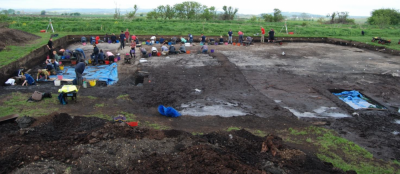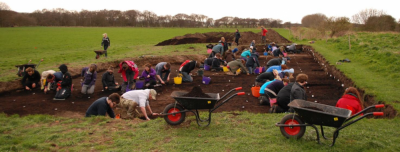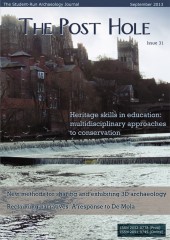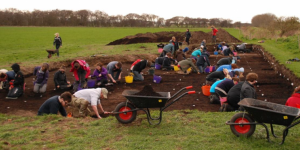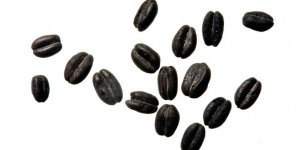This article will briefly summarise the research background of the famous Mesolithic site of Star Carr in the Vale of Pickering (North Yorkshire) and discuss the experiences of first year University of York undergraduate students, Sophie Austin (BA Archaeology) and Phoebe Haigh (BSc Archaeology), on their excavation fieldschool at the site.
First year undergraduates at the University of York’s Department of Archaeology spend three weeks of their summer term on fieldschool. This year, the Department offered a historical and a prehistoric option for students to participate in. This year, prehistorians (Figure 1) were delighted to learn that they would be digging at Star Carr, though under strict instructions to keep the excavation a secret until after it had finished in order to respect the landowners’ wishes as they did not want to attract publicity.
Excavated in the 1950s, Grahame Clark’s finds at Star Carr (then known as Site 4) elevated an otherwise unremarkable field in the Vale of Pickering to archaeological fame. In this article, we will briefly summarise the history of excavations at the site of Star Carr and around Lake Flixton as well as discussing the highlights of the dig and the more general experience of fieldschool.
Star Carr: A brief history
Star Carr is an extraordinary Mesolithic occupation site in the Vale of Pickering on the edge of palaeo-Lake Flixton. Preservation in waterlogged peat has been excellent until recent drainage schemes and so organic remains, such as wood, bone and antler, that would not normally survive have been conserved. The finds provided such insight into the Mesolithic that it has since been scheduled as a site of national importance (Emerick 2011, 125).
Excavation, including environmental sampling by Godwin and Walker, has taken place around palaeo-Lake Flixton since 1948 when John Moore, a local resident, discovered a flint blade in a ditch cut at Site 1, the nearby Flixton Island in the middle of the palaeo-lake. John Moore carried out initial excavations of Flixton Island and, after discovering further worked flint in another ditch cut, Star Carr.
The pioneering Mesolithic Archaeologist from Cambridge University, Grahame Clark excavated Star Carr for three years between 1949 and 1951. His finds included the 21 renowned antler headdresses, 191 barbed points, shale beads, large flint concentrations and deposits of birch branches. Following a substantial break, the project resumed in the 1980s and the new Vale of Pickering Research Trust collected environmental samples and exposed a number of substantial timbers with evidence of human modifications (Milner et al. 2013, 56).
In 2004, Nicky Milner, Barry Taylor and Chantal Conneller continued the work of creating a more extensive picture of the whole area of palaeo- Lake Flixton (Milner et al 2011, 5). Their finds included more worked timbers, deposits of animal bone, flint, antler, and, perhaps most excitingly, postholes suggesting a timber based structure; they also found a larger extent of human occupation than previously anticipated (Milner et al. 2013). The POSTGLACIAL Project is the recent culmination of attempts to understand the site more fully before changing conditions, a result of draining peat, oxygenation and increasing acidity, completely destroy the evidence of its occupation in the Mesolithic.
In the past few years in particular, methods such as thin section micromorphology, combined with microbotanical and geochemical analyses, have become increasingly recognised as providing an essential insight into several aspects of the archaeological record. An example of the resolution of this approach is the identification of individual layers of wall plasters at the site of Çatalhöyük in Turkey, revealing the seasonal redecorating habits of the Neolithic population (Matthews 2005).
The excavation and fieldschool experience
Both authors were excited about the prospect of excavation, especially at such an incredible site. Nevertheless, we were unsure of what to expect when we arrived at a road lay-by and set off on what felt like an intrepid walk towards the distant sight of three portable huts and a large mound of spoil. For those of us who had never excavated before, and even for those that had, being let loose on such an important Mesolithic site with a trowel seemed a bit overwhelming. Our supervisors made sure we felt comfortable though, and we soon got used to the strange experience of trekking out to the middle of a field every day to systematically reduce the build-up of sandy, silty re-deposited soil, through peat and clay and more peat and eventually right down to gravel.
As well as mastering (or perhaps merely grasping?) toweling, mattocking and shoveling (and of course the subtle art of shovel scraping) we practised section drawing and filling in context sheets. Initially, all of the groups had similar jobs, and the supervisors ensured that we all learnt the basics, but as the excavation developed, different areas of the trench produced varying artefacts or needed different levels of excavation so the five groups spread out in the trench by the middle of the field school, each conducting slightly different parts of the excavation (Figure 2).
Apart from archaeological skills, we found that we were learning more about the other students we were working with. It is amazing the obscure details about other people that you learn when spending nine hours together. We also learnt, by osmosis as well as directly, about the artefacts themselves. It was exciting to be finding some of the artefacts that would go towards new interpretations, or further contemplation of existing interpretations. Both authors felt that the fieldschool enabled them to learn a lot about the excavation process, an element which seems to many to be the defining character of the discipline of archaeology but which is difficult to appreciate without first-hand experience (Figure 3).
Post-excavation and evaluation
Following the fieldschool, each group took part in four days of post-excavation which built on our understanding of the processes which enable the artefacts found on excavation to be used to create interpretations of the site. We processed soil samples which involved a fun morning of standing with hands and forearms elbow-deep in cold water and an afternoon of sieving the sample and sorting it to extract its different constituent materials.
Students also participated in photo archiving and flint washing as well as looking at the heritage side of the excavation; this was part of the task of creating group heritage boards to display at an end of term exhibition. Many of those who found that the field element of the excavation was not their calling enjoyed the lab-based work more and everyone began to see the excavation process as more than just a few weeks of digging.
After the required three weeks of fieldschool had been completed, there was an opportunity for students who were interested in gaining more experience, or who simply had a great time on site, to volunteer more of their time to the project. Many people chose to revisit the site during the following final few weeks of the excavation.
Overall, the University of York’s fieldschool at Star Carr proved to be an amazing way of spending three (or more) weeks of the summer term. Even those who did not particularly enjoy the experience learnt from it and undoubtedly found it valuable. As for the authors of this article, we found that the experience firmly rooted our interest in the different branches of field archaeology. Hopefully everyone has blossomed from the experience and will continue to enjoy excavation.
Bibliography
- Emerick, K. (2011) ‘Management of Star Carr’. Journal of Wetland Arcaheology. 11 (1). 120-132
- Milner, N., Taylor, B., Conneller, C. and Schadla-Hall, T. (2013) Star Carr: Life in Britain after the Ice Age. York: Council for British Archaeology
- Milner, N., Lane, P., Taylor, B., Conneller, C. and Schadla-Hall, T. (2011) ‘Star Carr in a Postglacial Landscape: 60 Years of Research’. Journal of Wetland Arcaheology. 11 (1). 1-19
- Taylor, B. (2011) ‘Early Mesolithic Activity in the Wetlands of the Lake Flixton Basin’. Journal of Wetland Arcaheology. 11 (1). 68-84



